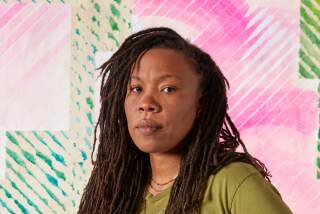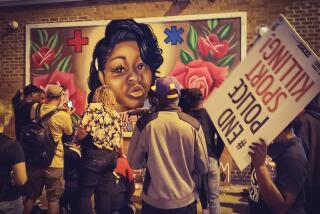Sanjena Sathian: After the Atlanta shooting, all I see is the fragility of our belonging
- Share via
I drive past Gold Spa and Aroma Therapy Spa — where a white gunman slaughtered four Asian American women on Tuesday — at least once a month. On that portion of my journey, I’m usually relaxed. It’s a pocket of Atlanta, halfway between my parents’ home and my own, that I think of as implicitly belonging to us — first- and second-generation Americans.
Atlanta and its suburbs are a surprisingly Whitmanesque experiment in pluralism, in which unpoetic concrete strip malls substitute for lyrical spears of summer grass. I grew up dipping in and out of strip malls like the suburban one housing Young’s Asian Massage — where the killer left another four dead. These structures are immigrant America: You can have your eyebrows threaded in a Pakistani-run salon wedged between an Ethiopian restaurant and a panadería and catty-corner from a Korean church. In Atlanta, as in other sprawling cities of millions, these spaces are where many new Americans go to make a life.
When Georgia flipped blue last year, pundits noted the swelling Asian population in Atlanta counties like Fulton; in suburban Gwinnett, the number of Asians doubled over the past 20 years. My family has lived this transformation. In the early 1990s, when I was 5 or so, I asked my parents if we were the only Indians in Atlanta. We knew other desis, but they were peripheral figures — people we saw at dosa restaurants and the Hindu temple — rather than my “real” life. I remember one other Asian kid in my elementary school class: I nursed a fervent crush on him, but our romance was doomed; he ran with the white bully who called me “Apu.” Those were lean times for self-recognition and solidarity. But in high school, I embedded in the heavily Asian American world of debate nerds. We’d send idiotic late-night AIMs and futz aimlessly around suburban malls; I felt safer, more myself, more at home.
Novelist Steph Cha writes that the face of anti-Asian violence has always been white. It’s the face of a system that devalues and scapegoats Asians.
This week, that hard-won sense of home feels diminished for so many. I am South Asian, which means that during this particular round of hate, my subset of Asianness is not under direct attack. I do not say this pro forma but to draw necessary attention to the infinite variety within “Asian America.” Due to racist vitriol blaming the COVID-19 pandemic on China, the physical abuse and harassment have fallen largely on East and Southeast Asian-presenting folks, especially women, elders and workers. And this particular tragedy — which Georgia police still refuse to call “racially motivated,” instead sympathetically citing the suspect’s stated desire to rid himself of sexual “temptations” — sits at a specific intersection of histories, many of which are not mine: the racist sexualization of East and Southeast Asian women dating to the 19th century and the erasure of working-class Asians.
These specific threads braid into something larger, which I recognize intimately. I was in Georgia in the years after 9/11, another period during which hollers of “Go back to your country” were in fashion. In the wake of the murder of Sikh American Balbir Singh Sodhi, I remember worrying about my parents, both doctors, who open their clinics’ doors to the community and with it the possibility of white rage; even more exposed were my friends’ parents who worked in liquor stores or ice cream franchises. That terror rose up again in 2017, when a white man in Kansas killed Srinivas Kuchibhotla, an Indian immigrant, after reportedly yelling “Get out of my country.” And so on, and so on.
For many Asian Americans, the killings further fueled fears about anti-Asian hatred that has mounted over the last year as police and advocacy groups have reported record numbers of hate crimes and harassment.
Tailing this fear is a suspicion that I have no right to it — a feeling many of my Asian American friends recognize. On paper, in aggregate, I am — we are — seen to be “doing well.” But one of the horrors of being in the minority is that the mainstream culture’s ability to fathom you is restricted. This, in turn, makes it harder to perceive yourself clearly. It requires an enormous act of will to force others not even to care but merely to see your reality.
White Americans too often remain locked into their own subjectivities: The Cherokee County sheriff — white — described the Atlanta shooting suspect as having had a “bad day” and praised his parents for being cooperative while reassuring reporters that the man accused of mass murder understood what he had done. It’s easy to guess why the officer put it that way; his empathy machine turned on when he saw someone who looked like him. I’ve seen this kind of failure of imagination before. The day after Kuchibhotla’s death, a man — white — told me he didn’t believe that the killer (white!) had really yelled “Get out of my country” or interrogated Kuchibhotla about his visa status. He’d never seen his brown friends treated that way. All minorities are, at some point, asked to speak ourselves into existence this way — to hold all the anger while also trying to just be people.
Steph Cha shares a meal and some notes on performing identity with the “Interior Chinatown” author.
So, if you are not already holding this anger, feel free to begin by expanding your imagination of the “Asian experience.” Sink into the work of scholars like Erika Lee or Vijay Prashad, documentarians like Vivek Bald, essayists like Cathy Park Hong and novelists like Charles Yu or Viet Thanh Nguyen. (Susan Choi’s first novel, “The Foreign Student,” is also one to think about.) Read about the legislative roots of the present “spike” in anti-Asianness — the Chinese Exclusion Act of 1882 and the functional ban on Asian immigration between 1917 and 1965. A pluralistic utopia — that Whitman dreamscape — depends on a shared narrative. Too many of us aren’t in the story at all.
Last night, I drove to my parents’ house for dinner. I passed the two spas, the microcosm of Asian Atlanta — the first-generation import grocery stores and the second-generation fusion restaurants. On another day, I might have pointed to this part of the country as proof that we had arrived. This week, all I can see is the fragility of our belonging. Strip malls, I realize now, are flimsy things. They’re easy to knock down.
The Atlanta man who admitted fatally shooting eight people, including six Asian women, claims race had nothing to do with it — so he’s a liar as well as a killer.
Sathian is the author of the novel “Gold Diggers” (Penguin Press, April 6), which takes place in suburban Georgia and Northern California.
More to Read
Sign up for our Book Club newsletter
Get the latest news, events and more from the Los Angeles Times Book Club, and help us get L.A. reading and talking.
You may occasionally receive promotional content from the Los Angeles Times.







